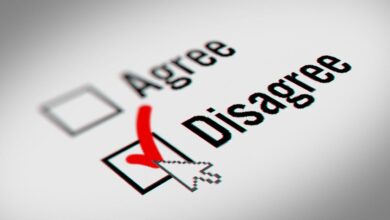
How to Resolve Conflict Remotely A Guide
How to resolve conflict remotely is a crucial skill in today’s digital world. Remote work and communication have become the norm, and with them comes the unique challenges of navigating disagreements across geographical distances and different communication styles. This guide delves into strategies for identifying, analyzing, and effectively resolving conflicts in remote settings, emphasizing clear communication, building rapport, and utilizing the right tools.
It’s about understanding the nuances of remote interactions and adapting conflict resolution techniques to this particular environment.
From understanding the distinct challenges of remote communication to implementing practical strategies for building trust and fostering collaboration, this comprehensive guide offers actionable steps for successfully navigating remote conflicts. We’ll explore various communication methods, analyze common conflict triggers, and discuss specific techniques for remote mediation. We’ll also touch upon the essential role of technology in supporting the process and how to adapt conflict resolution approaches to different cultural contexts.
Introduction to Remote Conflict Resolution
Remote conflict resolution involves addressing disagreements and disputes that arise between individuals or groups separated by distance, typically utilizing digital communication tools. It’s a rapidly growing necessity in today’s increasingly distributed workforces and globalized communities. Effectively navigating these conflicts requires a different approach than in-person interactions, recognizing and addressing the unique challenges presented by the lack of immediate nonverbal cues and the potential for miscommunication.Resolving conflict remotely necessitates a heightened awareness of communication styles, active listening, and a proactive approach to managing potential misunderstandings.
This includes a deliberate effort to create a safe and supportive virtual environment where all parties feel heard and respected. The ability to quickly identify and address potential escalations is crucial in maintaining a positive outcome.
Key Challenges of Remote Conflict Resolution
Remote conflict resolution presents unique challenges compared to in-person interactions. The absence of immediate nonverbal cues, such as facial expressions and body language, can lead to misinterpretations and escalate tensions. Additionally, the lack of shared physical space can create a sense of distance and detachment, making it harder to build rapport and trust. Effective communication strategies are paramount in mitigating these challenges.
Importance of Clear Communication in Remote Conflict Resolution
Clear communication is the cornerstone of successful remote conflict resolution. It involves choosing the appropriate communication channels, ensuring messages are concise and unambiguous, and actively seeking clarification when needed. A crucial element is ensuring all parties understand the context and perspectives of the others involved. Using tools that allow for written records of conversations and agreements further strengthens clarity and accountability.
Comparison of In-Person and Remote Conflict Resolution
Understanding the differences between in-person and remote conflict resolution strategies is essential for effective management. This table highlights key distinctions:
| Feature | In-Person | Remote |
|---|---|---|
| Communication Channels | Face-to-face, body language | Email, messaging apps, video calls |
| Nonverbal Cues | Visible | Often missed or misinterpreted |
| Building Rapport | Easier | More challenging |
| Escalation Management | Can be observed and addressed | Risk of quick escalation |
Remote conflict resolution demands a more structured and proactive approach. Recognizing the unique challenges and prioritizing clear communication are vital for navigating these situations effectively and achieving positive outcomes.
Identifying and Analyzing Remote Conflicts
Pinpointing the root causes of disagreements across geographical distances requires a nuanced approach. Simply addressing surface-level communication issues won’t resolve underlying problems. Effective remote conflict resolution demands a deep dive into the specific dynamics and patterns of interaction. This involves meticulous analysis of communication styles, triggers, and individual motivations.Effective conflict resolution starts with a keen understanding of the conflict’s origins.
Knowing the “why” behind the “what” is crucial for implementing appropriate strategies. This involves digging deeper than the immediate statements and exploring the underlying reasons for the conflict.
Methods for Identifying the Source of a Remote Conflict
Understanding the source of a remote conflict necessitates a multifaceted approach. Active listening and careful observation of communication patterns are paramount. The focus should be on identifying recurring themes, emotional responses, and communication styles that might be exacerbating the situation. Direct questioning about the perceived source of the problem, while sensitive, can offer valuable insights.
Strategies for Gathering Information from Remote Parties
Gathering comprehensive information from remote parties requires sensitivity and a structured approach. Utilizing various communication tools, such as video conferencing, instant messaging, or collaborative document platforms, allows for direct interaction and data collection. Establishing clear communication protocols, including designated channels for feedback and suggestions, helps in managing the flow of information. Furthermore, encouraging open dialogue and active listening through these mediums can foster trust and understanding.
Strategies for Identifying Patterns and Triggers in Remote Communication
Identifying patterns and triggers in remote communication involves meticulous observation of communication styles and reactions. Analyzing past interactions, focusing on recurring themes or phrases, and noting the timing and context of disagreements are essential. This process helps in identifying specific triggers that escalate the conflict. For instance, a particular tone of voice or a specific phrase may repeatedly evoke negative responses.
Common Remote Conflict Triggers
Remote communication can be challenging due to various factors. Misunderstandings arise from the absence of nonverbal cues, which are often critical in face-to-face interactions. Difficulties in expressing emotions effectively, or the perceived lack of attention to certain issues, can also be significant triggers. Technical problems, like audio or video glitches, can contribute to misunderstandings and frustration, ultimately escalating the conflict.
Time zone differences, differing communication styles, and varying levels of digital literacy can also lead to communication breakdowns. The lack of immediate feedback and the inability to read body language can lead to a disconnect, causing frustration.
- Misinterpretations: Due to the absence of nonverbal cues, remote communication can easily lead to misinterpretations of tone, intent, and meaning. For example, an email that seems assertive might be perceived as aggressive in the absence of facial expressions or tone of voice.
- Lack of Nonverbal Cues: This absence of nonverbal cues can be particularly problematic when discussing emotionally charged issues. The lack of body language and facial expressions can contribute to misunderstandings and escalate conflict.
- Technical Difficulties: Interruptions or technical glitches can disrupt the flow of communication and create a sense of frustration and mistrust.
- Time Zone Differences: Scheduling meetings and responding to messages can become challenging, leading to feelings of being ignored or undervalued.
Framework for Analyzing Underlying Causes of Remote Disputes
Analyzing the underlying causes of remote disputes requires a framework that considers the interplay of individual factors, communication styles, and systemic issues. The framework should include an assessment of individual personalities, communication preferences, and emotional responses. Furthermore, it should evaluate communication channels, tools, and protocols in place to ensure they support productive dialogue. The systemic context, including organizational structures, policies, and procedures, should also be considered.
Communication Styles and Conflict, How to resolve conflict remotely
Different communication styles can significantly impact remote conflict resolution. Understanding these styles and their potential contributions to conflict is crucial. The following table illustrates potential correlations between communication styles and their influence on remote disputes.
| Communication Style | Potential Contribution to Conflict | Example |
|---|---|---|
| Passive | May appear unassertive, allowing others to take advantage, or be ignored in discussions. | A team member repeatedly avoids expressing concerns about project deadlines, potentially leading to missed deliverables. |
| Aggressive | Can be perceived as confrontational and disrespectful, alienating others and escalating conflict. | A project leader constantly interrupts team members and dismisses their input, leading to resentment. |
| Passive-Aggressive | Indirectly expresses dissatisfaction, leading to misunderstandings and resentment. | A team member consistently delays responding to emails or assignments, creating tension without directly addressing the issue. |
| Assertive | Directly communicates needs and concerns, fostering respectful dialogue and collaboration. | A team member clearly expresses concerns about a project’s timeline and suggests solutions for improvement, creating a constructive discussion. |
Effective Communication Strategies in Remote Settings
Navigating conflicts remotely requires specialized communication skills. Simply exchanging emails or instant messages can often exacerbate tensions. Effective strategies involve thoughtful consideration of the medium, active listening, and empathetic expression. This section dives into crucial communication methods and techniques for resolving conflicts in a virtual environment.Remote conflict resolution demands a shift in perspective from face-to-face interactions. Understanding the nuances of different communication channels, along with the importance of active listening and empathy, is critical to successful outcomes.
Effective communication fosters mutual understanding and de-escalates tension, enabling parties to collaboratively find solutions.
Further details about cima ethics confidentiality rules is accessible to provide you additional insights.
Communication Methods Suitable for Remote Conflict Resolution
Various communication methods can facilitate productive remote conflict resolution. Choosing the right tool is crucial for clarity and efficiency.
- Video conferencing platforms like Zoom, Google Meet, or Microsoft Teams are ideal for complex discussions. Visual cues, such as facial expressions and body language (though limited), can aid in understanding context and emotional responses.
- Audio conferencing, while less nuanced, can be useful for brief discussions or when visual interaction isn’t essential.
- Instant messaging (IM) platforms like Slack or Microsoft Teams can be used for quick questions or updates, but should be used sparingly for complex or sensitive conversations to avoid misunderstandings.
- Email communication is best for documenting agreements or summarizing decisions reached during more complex discussions.
Importance of Active Listening in Remote Communication
Active listening is fundamental in any conflict resolution, especially in remote settings. It involves focusing intently on the speaker’s words, both verbal and nonverbal, and responding thoughtfully.Active listening in remote settings requires extra effort to compensate for the lack of nonverbal cues. This includes consciously focusing on the speaker’s tone of voice, using clarifying questions to confirm understanding, and summarizing key points to demonstrate comprehension.
Strategies for Conveying Empathy and Understanding in Remote Interactions
Empathy is essential in resolving conflicts. It involves acknowledging and validating the other person’s perspective, even if you don’t agree with it.
- Acknowledge the other person’s feelings by using phrases like, “I understand that you feel…” or “It sounds like you’re feeling…” This demonstrates that you’re trying to understand their perspective.
- Use reflective listening by summarizing the other person’s points and feelings to ensure accurate understanding.
- Ask open-ended questions to encourage the other person to share their thoughts and feelings, and validate their emotional experience.
- Avoid interrupting or dismissing the other person’s concerns. Give them space to express themselves fully.
Using Clarifying Questions in Remote Discussions
Clarifying questions help ensure mutual understanding. They are particularly important in remote communication where nonverbal cues are absent.Using clarifying questions is vital to avoid misinterpretations. These questions ensure that all parties are on the same page, fostering a common understanding of the issues. Examples include, “Can you elaborate on…?” or “Could you provide an example of…?”
Assertive Communication Techniques Applicable in Remote Settings
Assertive communication involves expressing your thoughts and feelings clearly and respectfully while respecting the other person’s perspective.
- Clearly state your needs and concerns without resorting to accusations or personal attacks. Focus on the specific issue at hand, not the individual.
- Use “I” statements to express your feelings and opinions without placing blame. For example, instead of saying “You always…”, try “I feel…” or “I notice…”
- Listen actively to the other person’s response and acknowledge their perspective. This demonstrates respect and encourages a collaborative approach.
- Maintain a professional and respectful tone, even when emotions run high. Remember, the communication is being recorded or documented, and maintaining a calm and controlled tone is crucial.
Comparison of Communication Platforms for Conflict Resolution
| Communication Platform | Strengths | Weaknesses | Suitability for Conflict Resolution |
|---|---|---|---|
| Video Conferencing (Zoom, Google Meet) | Visual cues, real-time interaction, non-verbal communication | Potential for technical difficulties, screen sharing issues | High |
| Audio Conferencing (Phone Calls) | Simplicity, readily available | Lack of visual cues, limited nuance | Medium |
| Instant Messaging (Slack, Teams) | Quick communication, easy to access | Difficult to convey emotions, prone to misinterpretations | Low (unless for quick follow-ups) |
| Formal record, documentation | Slow, lack of real-time interaction, can escalate tensions | Low (unless for follow-up) |
Strategies for Building Rapport and Trust
Building trust and rapport is crucial for effective remote conflict resolution. Without a foundation of trust, even the best communication strategies can fail. Remote work environments, by their nature, often lack the informal interactions and nonverbal cues that foster connection in person. Therefore, proactive strategies are needed to cultivate a sense of community and understanding. This section explores methods for building rapport and trust in remote settings, focusing on establishing a positive and collaborative environment.
Establishing Trust in Virtual Interactions
Establishing trust in a virtual environment requires conscious effort and consistent application of positive strategies. Participants must be seen as reliable, respectful, and invested in the collaborative process. Open communication, clear expectations, and consistent follow-through are essential. Transparent communication, outlining the team’s process, and demonstrating a commitment to shared goals are all key to building trust.
Empathy and Active Listening
Empathy and active listening are cornerstones of building trust and rapport. Active listening goes beyond simply hearing; it involves understanding the speaker’s perspective, acknowledging their feelings, and validating their experiences. This requires a conscious effort to put yourself in the other person’s shoes. By actively seeking to understand the speaker’s viewpoint, even if you disagree, you demonstrate respect and create a safe space for open communication.
Leveraging Shared Experiences and Interests
Shared experiences and interests can create common ground and foster a sense of connection. Finding common interests, even outside of work, can help individuals feel more comfortable and connected. This might involve organizing virtual coffee breaks, sharing personal interests in informal chat channels, or even creating virtual team-building activities centered on hobbies or shared experiences. These activities create opportunities for informal interaction and help build rapport.
Creating a Safe Space for Dialogue
Creating a safe space for dialogue is vital in remote settings. Encourage open communication, where participants feel comfortable expressing their views without fear of judgment or retribution. Establish clear ground rules for respectful dialogue and create an environment where diverse opinions are valued. This could involve setting expectations around appropriate language and behavior, emphasizing active listening, and modeling respectful interactions.
Explicitly stating that all contributions are valuable and respected is critical.
Remote Team Building and Conflict Prevention Strategies
| Method | Description | Benefits |
|---|---|---|
| Virtual Coffee Breaks/Check-ins | Short, informal virtual meetings to foster casual interaction and build rapport. | Reduces feelings of isolation, encourages informal communication, builds connections. |
| Team-Building Activities (e.g., virtual games, challenges) | Activities designed to promote teamwork and interaction outside of work-related tasks. | Enhances collaboration, fosters a sense of camaraderie, builds trust through shared experiences. |
| Regular Feedback Mechanisms | Establish clear feedback channels, both formal and informal. | Identifies potential conflicts early, fosters a culture of open communication, allows for addressing concerns proactively. |
| Shared Documents/Project Management Tools | Utilize collaborative tools to enhance transparency and shared understanding. | Enhances visibility into each other’s work, promotes transparency, minimizes ambiguity. |
Conflict Resolution Techniques Specific to Remote Environments

Navigating disagreements across geographical boundaries requires specialized strategies. Remote conflict resolution necessitates a nuanced approach, considering the unique challenges of virtual interaction. Understanding the specific dynamics of remote communication, including potential for misinterpretation and the lack of nonverbal cues, is paramount to effective intervention.Remote settings often magnify existing interpersonal tensions. The absence of immediate, in-person feedback can lead to misunderstandings escalating quickly.
Consequently, carefully crafted communication and structured conflict resolution processes are vital for maintaining productive and harmonious remote teams.
Mediation Strategies in Remote Settings
Mediation in remote environments necessitates adapting traditional techniques to the digital space. Effective remote mediation relies heavily on the chosen communication platform. Video conferencing, with its visual element, offers a richer experience compared to solely text-based communication. Clear guidelines regarding meeting etiquette and the use of shared documents are crucial. The mediator must be adept at managing the technical aspects of the meeting and ensure all participants have equal access to communication tools.
Collaborative Problem-Solving Techniques
Remote collaborative problem-solving requires a structured approach. Tools like shared documents, whiteboards, and project management software facilitate collective brainstorming and idea generation. Regular check-ins and updates through these platforms are critical to maintain momentum and transparency. Using a structured problem-solving methodology, like the “Five Whys,” can help teams dig deeper into the root causes of conflicts. Examples of collaborative problem-solving in remote teams include using online surveys to gauge team consensus on solutions and using interactive polls to gain input on various approaches.
Role of Technology in Facilitating Remote Conflict Resolution
Technology plays a crucial role in supporting remote conflict resolution. Communication platforms, video conferencing tools, and project management software offer valuable tools for facilitating discussions, managing information, and fostering a sense of shared space. Tools like Slack or Microsoft Teams can be leveraged to create designated channels for conflict resolution discussions, ensuring privacy and controlled communication. Secure file sharing is essential to maintain confidentiality in sensitive discussions.
Moreover, remote platforms can support the creation of virtual meeting rooms that can enhance interaction and maintain a sense of team presence.
Documenting Remote Conflict Resolution Processes
Documenting remote conflict resolution is crucial for learning from past experiences and improving future interactions. A comprehensive record of discussions, agreements, and decisions helps to avoid repeating similar conflicts. A shared online document, accessible to all participants, can be utilized to maintain an accurate record of the resolution process. The document should include dates, times, participants, key decisions, and agreed-upon actions.
Comparison of Conflict Resolution Models in Remote Settings
| Model | Description (Remote Context) | Strengths | Weaknesses |
|---|---|---|---|
| Facilitative Mediation | A neutral third party guides the disputing parties toward a mutually acceptable resolution. | Effective in fostering understanding and promoting dialogue, especially when there are communication barriers. | May not be effective if underlying power imbalances are significant or if parties are unwilling to engage constructively. |
| Transformative Mediation | Focuses on shifting the parties’ perspectives and empowering them to resolve the conflict themselves. | Can address the root causes of conflict, leading to lasting solutions. Remote setting facilitates more thoughtful responses and reduced emotional reactions. | Can be time-consuming if parties are resistant to changing their perspectives. Requires skilled mediators to navigate emotional dynamics remotely. |
| Collaborative Problem-Solving | Teams work together to identify the problem, brainstorm solutions, and implement a chosen approach. | Effective in involving all parties in the process and promotes shared ownership of solutions. | Requires strong leadership and commitment from all parties, which can be challenging to achieve in a remote setting. May be hindered by differing work styles and communication preferences. |
Tools and Technologies for Remote Conflict Resolution

Bridging the physical distance in conflict resolution requires leveraging the right digital tools. Effective remote conflict resolution hinges on choosing platforms that foster open communication, facilitate collaboration, and promote trust among participants. The selection of appropriate tools significantly impacts the overall success and efficiency of the mediation process.Technology plays a crucial role in enabling remote conflict resolution by providing channels for communication, collaboration, and transparency.
These tools are designed to streamline the process, minimize misunderstandings, and ultimately lead to more constructive outcomes. Choosing the right tools is vital for effective remote mediation.
Video Conferencing Platforms for Mediation
Video conferencing platforms are essential for facilitating face-to-face interactions in remote settings. These platforms allow mediators and participants to see and hear each other, creating a sense of presence and enabling nonverbal cues to be observed. A crucial aspect of choosing a platform is ensuring its features support active listening, respectful dialogue, and maintaining a structured discussion. Platforms like Zoom, Google Meet, and Microsoft Teams offer features like screen sharing, breakout rooms, and recording capabilities, enhancing the effectiveness of remote mediation.
These features enable mediators to guide the conversation, facilitate structured discussions, and ensure everyone feels heard.
Collaborative Document Editing Tools for Conflict Resolution
Collaborative document editing tools are invaluable for documenting agreements, outlining proposals, and recording minutes of meetings. These tools allow multiple parties to simultaneously work on a document, fostering transparency and a sense of shared ownership in the process. Real-time collaboration ensures everyone is on the same page and reduces the potential for misunderstandings stemming from differing interpretations of information.
Google Docs, Microsoft Word Online, and other similar platforms are effective tools for this purpose.
Communication Platforms for Remote Teams
Effective communication platforms facilitate transparency and encourage participation from all parties involved in the conflict. They are crucial for maintaining a structured and organized environment, promoting active listening, and facilitating the sharing of information. Dedicated communication channels, like Slack, Microsoft Teams, or Discord, enable the creation of designated spaces for different discussion topics, which can include information about the conflict resolution process.
These platforms can also be used to share relevant documents, updates, and other crucial information. By utilizing these platforms, parties can maintain clear communication lines and ensure everyone is informed about the progress of the mediation.
Remote Conflict Resolution Training Resources
Numerous resources provide training and support for professionals involved in remote conflict resolution. These resources offer valuable insights into best practices for mediating conflicts in virtual environments, helping mediators adapt their techniques to the specific challenges of remote communication. Organizations like the Harvard Negotiation Project, online courses on platforms like Coursera and Udemy, and professional development workshops offer training in this area.
Comparison of Remote Conflict Resolution Tools
| Tool | Pros | Cons |
|---|---|---|
| Zoom | Versatile features (screen sharing, breakout rooms), user-friendly interface | Potential for technical glitches, security concerns if not used cautiously |
| Google Meet | Free tier available, integrates well with other Google services | Limited features compared to some paid platforms, potential for audio/video quality issues in less stable internet connections |
| Microsoft Teams | Integrated communication platform, excellent for team collaboration, robust features | Can be complex for those unfamiliar with the platform, subscription-based, may require specific training |
| Google Docs | Real-time collaboration, easy version control, free | May not be suitable for complex documents, limited features for non-document collaboration |
| Slack | Facilitates team communication, organized channels, useful for quick updates and discussions | Not ideal for in-depth discussions or detailed document sharing, may overwhelm users if not properly managed |
Case Studies and Examples of Remote Conflict Resolution: How To Resolve Conflict Remotely
Remote work has undeniably increased the need for effective conflict resolution strategies. Successfully navigating disagreements in a virtual environment requires a nuanced approach that goes beyond traditional in-person methods. This section explores real-world scenarios, highlighting both successful and challenging aspects of remote conflict resolution.
A Successful Remote Conflict Resolution Case Study
A software development team, working remotely across different time zones, experienced disagreements regarding project deadlines and task allocation. The team leader, recognizing the issue, implemented a proactive approach. Regular virtual team meetings were scheduled, focusing on open communication and collaborative problem-solving. Specific project tasks were broken down into smaller, more manageable components, with clear deadlines and assigned responsibilities.
This fostered a sense of shared ownership and accountability, significantly reducing friction. Transparent documentation of decisions and progress updates, shared through a dedicated project management platform, helped maintain clarity and prevent misunderstandings. The team effectively resolved the conflict, improving team morale and project completion rates.
A Challenging Remote Conflict Resolution Scenario
A marketing team, dispersed geographically, faced a conflict stemming from differing interpretations of campaign strategies. Initial attempts at resolution through email exchanges proved ineffective, leading to escalating frustrations and a sense of disconnect. The core issue wasn’t the strategy itself, but rather a lack of shared understanding about the intended audience and the overall marketing goals. The absence of informal, face-to-face interactions, which allow for subtle cues and context, compounded the issue.
Ultimately, the team leader facilitated a series of virtual brainstorming sessions, emphasizing active listening and clear articulation of viewpoints. A shared document outlining the marketing goals and strategies, with specific examples, helped bridge the gap. Despite initial challenges, the team successfully resolved the conflict through increased transparency and proactive communication.
Successful Strategies Used in Remote Conflict Resolution
Effective strategies for remote conflict resolution often involve a combination of techniques. Clear and concise communication is paramount. Actively listening to different perspectives, even those that disagree with your own, is essential. Establishing clear expectations and procedures, documented and accessible to all team members, minimizes ambiguity. Employing collaborative tools like video conferencing, shared documents, and project management software can facilitate smoother communication and collaboration.
A willingness to adapt to different communication styles and cultural norms is crucial for success.
Communication Breakdowns in Remote Conflict Scenarios
Communication breakdowns in remote conflict scenarios frequently stem from misunderstandings. Lack of non-verbal cues, such as body language and tone of voice, can lead to misinterpretations. Over-reliance on text-based communication, especially emails, can easily result in miscommunications and missed opportunities for clarification. The absence of casual interactions, which help build rapport and trust, can create a sense of detachment.
Delayed responses to messages, or a perceived lack of responsiveness, can escalate tensions. Inconsistent or unclear instructions can also contribute to conflicts.
Adapting Conflict Resolution Strategies Based on Cultural Differences
Cultural nuances significantly impact communication styles and conflict resolution approaches. Different cultures value directness versus indirectness in communication. Understanding these differences is critical for successful resolution. For instance, some cultures prioritize harmony and avoiding confrontation, while others favor a more assertive approach. Being mindful of these cultural factors ensures the resolution strategy is culturally sensitive and avoids inadvertently causing offense.
Respectful dialogue, patience, and a willingness to understand diverse perspectives are key components of adapting conflict resolution strategies to cultural differences. Empathetic listening and acknowledging cultural differences are important elements.
Key Takeaways from the Case Studies
“Effective remote conflict resolution requires proactive communication, clear expectations, and a commitment to understanding diverse perspectives. Utilizing collaborative tools and adapting strategies to cultural nuances are crucial elements for success. Addressing conflicts promptly and constructively can foster stronger team relationships and enhance project outcomes.”
Last Word
In conclusion, resolving conflicts remotely requires a multifaceted approach that combines understanding the unique dynamics of virtual interactions with practical strategies for communication, building rapport, and utilizing appropriate tools. This guide has provided a roadmap for navigating these complexities, equipping you with the knowledge and techniques necessary to address disagreements constructively and effectively in a remote environment. Remember, proactive communication and a focus on understanding are key to successful conflict resolution, no matter the distance.



